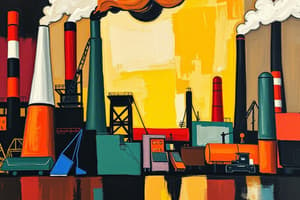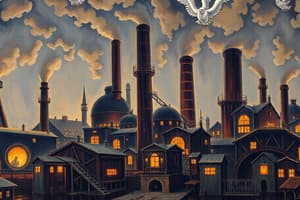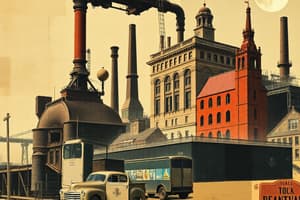Podcast
Questions and Answers
Which of the following is NOT a key question explored in global economic history?
Which of the following is NOT a key question explored in global economic history?
- How can we achieve global economic equality? (correct)
- When did sustained economic growth begin?
- What factors influence economic divergence among nations?
- Why is one region more developed than another?
The Industrial Revolution marked a significant shift from a period of economic growth to a period of economic stagnation.
The Industrial Revolution marked a significant shift from a period of economic growth to a period of economic stagnation.
False (B)
What is the term used to describe the period when the West industrialized while other regions lagged behind?
What is the term used to describe the period when the West industrialized while other regions lagged behind?
The Great Divergence
The Neolithic Revolution witnessed a shift from ______ societies to ______ agricultural communities.
The Neolithic Revolution witnessed a shift from ______ societies to ______ agricultural communities.
Which of these theories explains the shift to agriculture by emphasizing the influence of available domesticable plants and animals?
Which of these theories explains the shift to agriculture by emphasizing the influence of available domesticable plants and animals?
Match the following consequences of the Neolithic Revolution with their respective categories:
Match the following consequences of the Neolithic Revolution with their respective categories:
Thomas Malthus argued that population growth outpaces food production, leading to perpetual poverty.
Thomas Malthus argued that population growth outpaces food production, leading to perpetual poverty.
What is GDP per capita and how is it used?
What is GDP per capita and how is it used?
What is the primary consequence of the Malthusian Trap?
What is the primary consequence of the Malthusian Trap?
The Industrial Revolution marked a significant break from the agrarian economy.
The Industrial Revolution marked a significant break from the agrarian economy.
What were Positive Checks in the context of the Malthusian Trap?
What were Positive Checks in the context of the Malthusian Trap?
The Golden Age of Islam took place between ______ and ______ CE.
The Golden Age of Islam took place between ______ and ______ CE.
Match the following stages of the Demographic Transition with their characteristics:
Match the following stages of the Demographic Transition with their characteristics:
What role did the Glorious Revolution of 1688 have in Britain's industrial development?
What role did the Glorious Revolution of 1688 have in Britain's industrial development?
China led the world in industrialization between 1500 and 1900.
China led the world in industrialization between 1500 and 1900.
What technological advancement was made by James Watt in 1776?
What technological advancement was made by James Watt in 1776?
The European Marriage Pattern is characterized by a high marriage age of around ______ years.
The European Marriage Pattern is characterized by a high marriage age of around ______ years.
Which factor significantly contributed to the Great Divergence between Europe and Asia?
Which factor significantly contributed to the Great Divergence between Europe and Asia?
Flashcards
Economic Growth
Economic Growth
A sustained increase in prosperity, measured by GDP per capita.
Economic Development
Economic Development
Structural changes in an economy leading to improved human well-being.
GDP per Capita
GDP per Capita
A measure of total output per person, used to compare economic prosperity.
Great Divergence
Great Divergence
Signup and view all the flashcards
Neolithic Revolution
Neolithic Revolution
Signup and view all the flashcards
Population Pressure Hypothesis
Population Pressure Hypothesis
Signup and view all the flashcards
Malthusian Theory
Malthusian Theory
Signup and view all the flashcards
Consequences of the Neolithic Revolution
Consequences of the Neolithic Revolution
Signup and view all the flashcards
Malthusian Trap
Malthusian Trap
Signup and view all the flashcards
Positive Checks
Positive Checks
Signup and view all the flashcards
Preventive Checks
Preventive Checks
Signup and view all the flashcards
European Marriage Pattern (EMP)
European Marriage Pattern (EMP)
Signup and view all the flashcards
Industrial Revolution
Industrial Revolution
Signup and view all the flashcards
David Landes' Comparison
David Landes' Comparison
Signup and view all the flashcards
Stages of Demographic Transition
Stages of Demographic Transition
Signup and view all the flashcards
Role of Human Capital
Role of Human Capital
Signup and view all the flashcards
Confucian Stability vs. European Innovation
Confucian Stability vs. European Innovation
Signup and view all the flashcards
Study Notes
Global Economic Development: A Bird's Eye View
- Early economic growth was almost nonexistent before 1750.
- The Industrial Revolution (1750-1850) marked a turning point, breaking from stagnation.
- The modern growth regime (post-1870) saw increasing global economic disparities.
- The "Great Divergence" describes how the West industrialized, leaving other regions behind.
- Economic growth is measured by GDP per capita, representing total output per person.
- Economic development encompasses structural changes in the economy, leading to improved human well-being.
The Neolithic Revolution (~10,000 BCE)
-
The shift from nomadic hunter-gatherer societies to settled agricultural communities.
-
Occurred independently in regions like the Fertile Crescent, China, and Mesoamerica.
-
Led to permanent settlements, specialization, and technological innovations.
-
The shift to agriculture was potentially driven by climate change, population growth, geography and economic factors.
-
Consequences of the Neolithic Revolution:
- Economic: Stable food supply led to population growth, specialization in labor, and private property.
- Social: Rise of complex societies, shifted gender roles, and increased conflict.
- Negative Outcomes: Higher disease risks, malnutrition, and social inequalities like slavery.
The Malthusian Epoch (Pre-Industrial Society)
-
Thomas Malthus' Theory (1798): Population grows faster than food supply; this creates a cycle of poverty.
-
Malthusian Trap: Rising income leads to population growth, keeping living standards low.
-
Checks on population: Famine, disease, and war curb population growth (these are positive checks).
-
Preventive checks: Delayed marriage and limited birth control keep population growth in check.
-
Defining Characteristics: Mass poverty with near-subsistence living standards, high birth and death rates, and limited escape from poverty except for the elites.
-
European Marriage Pattern (EMP): High marriage age hindered fertility compared to other regions contributing to higher per capita income.
-
Short-term Economic Booms:
- Golden Age of Islam (850-1050 CE): Agricultural advancements and financial innovations
- Song China (960-1279 CE): Paper money, iron production, and urbanization
- Dutch Golden Age (1588-1720 CE): Early stock market, and colonial expansion.
The Industrial Revolution (1750-1850)
- A fundamental shift from agrarian economies to industrial production.
- Reasons for Britain's lead:
- Institutions: Stable government, secure property rights.
- Factor Prices: High wages and cheap coal incentivized labour-saving technologies.
- Knowledge/Culture: Industrial enlightenment promoted knowledge sharing and scientific progress.
- Key Innovations: The steam engine, the spinning jenny, and railways.
- Consequences:
- Economic: Urbanization, industrial capitalism, increased productivity, and rising living standards for some.
- Social: Emergence of the working class, child labor, and poor working conditions.
- Global: Europe industrialized while other regions lagged.
The Demographic Transition
- Stages of decreased mortality rates and birth rates: Initially, high birth and death rates, then declining death rates (with high fertility), and finally, declining birth rates resulting from investment in human capital (education, etc.).
- Role of Human Capital: Essential for industrial labor, parents prioritizing education over large families.
- Economic Implications: Shift from agricultural to factory work, rising life expectancy, and improved health.
Divergence and its Historical Origins
-
Great Divergence (Europe vs. Asia):
- Institutional Argument: Europe's fragmented states fostered competition, while China's centralized governance lacked it.
- Economic Structure: Britain industrializing using coal and colonial resources, compared to China remaining agrarian.
- Cultural Factors: Europe's Enlightenment promoted scientific progress while Confucianism emphasized stability.
- Technological Lag: Europe's scientific revolution fueled ongoing progress while other regions experienced innovation that slowed.
-
Little Divergence (Northwestern vs. Mediterranean Europe): Northwestern Europe's early urbanization, banking, and trade led industrialization ahead of others.
-
Middle East's Decline:
- Kuran's Argument: Islamic inheritance laws and lack of corporate institutions hindered capital accumulation and economic dynamism.
Studying That Suits You
Use AI to generate personalized quizzes and flashcards to suit your learning preferences.




